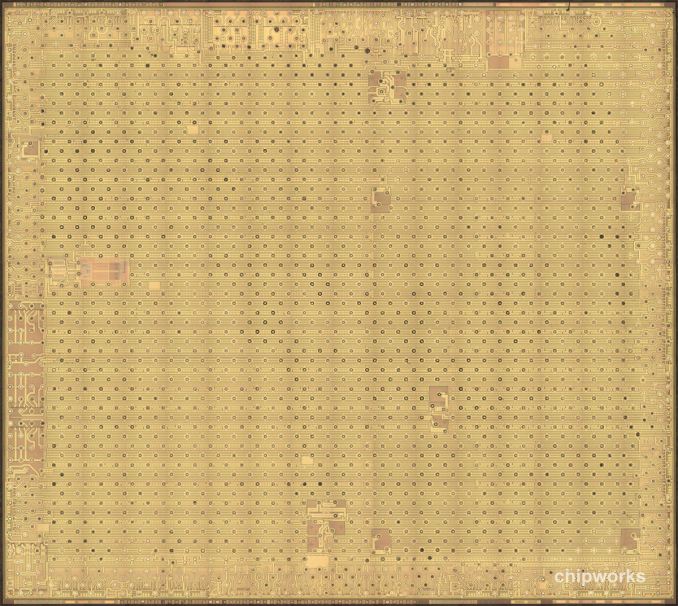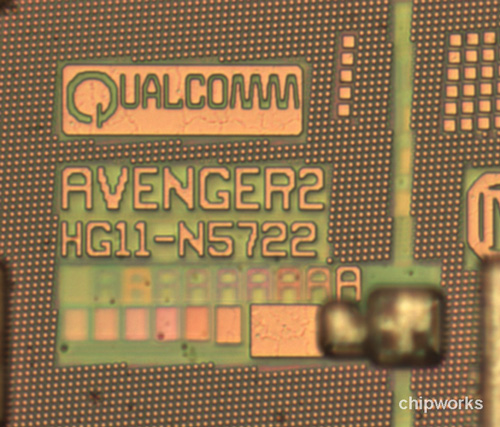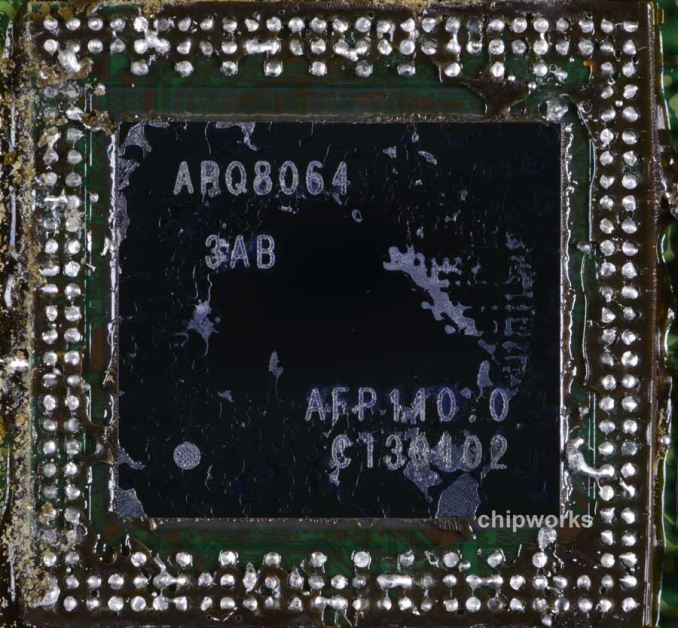Samsung Galaxy S 4 Review - Part 1
by Brian Klug on April 24, 2013 12:01 AM ESTGalaxy S 4 - Powered by a Better Snapdragon 600 (APQ8064AB)?
At a high level, Samsung's Galaxy S 4 integrates Qualcomm's Snapdragon 600 SoC. From what Qualcomm told us about Snapdragon 600, we're dealing with four Krait 300 cores and an Adreno 320 GPU. The Krait 300 cores themselves are supposed to improve performance per clock over the original Krait CPU (Krait 200) through a handful of low level microarchitectural tweaks that we've gone through here. The Krait 300 design also allegedly improves the ability to run at higher frequencies without resorting to higher voltages. This isn't the first time we've talked about Snapdragon 600, but since then a few things have come to light.

Snapdragon 600 from HTC One - Chipworks
For starters, Chipworks got their hands on a Snapdragon 600 SoC (from an HTC One) and delayered the SoC. In its investigation, Chipworks discovered that Snapdragon 600 had the exact same die area as the previous generation Snapdragon S4 Pro (APQ8064). Also, although you'd expect APQ8064T markings on the chip itself, the part carried the same APQ8064 label as previous S4 Pro designs.

Avenger 2 Markings on Snapdragon 600 die from HTC One - Chipworks
Chipworks did note however that there were some subtle differences between a standard APQ8064 and the Snapdragon 600 SoC from the HTC One. The Snapdragon 600 from the One is labeled with an Avenger2 codename rather than Avenger, the latter was apparently present on prior APQ8064 designs. Chipworks also noticed differences in the topmost metal layer, although it's not clear whether or not they stopped there or found no differences in lower layers.
All of this points to a much more subtle set of physical differences between APQ8064 and the earliest Snapdragon 600s. Metal layer changes are often used to fix bugs in silicon without requiring a complete respin which can be costly and create additional delays. It's entirely possible that Krait 300 was actually just a bug fixed Krait 200, which would explain the identical die size and slight differences elsewhere.
That brings us to the Galaxy S 4. It's immediately apparent that something is different here because Samsung is shipping the Snapdragon 600 at a higher frequency than any other OEM. The Krait 300 cores in SGS4 can run at up to 1.9GHz vs. 1.7GHz for everyone else. Curiously enough, 1.9GHz is the max frequency that Qualcomm mentioned when it first announced Snapdragon 600.
Samsung is obviously a very large customer, so at first glance we assumed it could simply demand a better bin of Snapdragon 600 than its lower volume competitors. Looking a bit deeper however, we see that the Galaxy S 4 uses something different entirely.
APQ8064 from a Snapdragon 600 based HTC One - Chipworks
Digging through the Galaxy S 4 kernel source we see references to an APQ8064AB part. As a recap, APQ8064 was the first quad-core Krait 200 SoC with no integrated modem, more commonly referred to as Snapdragon S4 Pro. APQ8064T was supposed to be its higher clocked/Krait 300 based successor that ended up with the marketing name Snapdragon 600. APQ8064AB however is, at this point, unique to the Galaxy S 4 but still carries the Snapdragon 600 marketing name.
If we had to guess, we might be looking at an actual respin of the APQ8064 silicon in APQ8064AB. Assuming Qualcomm isn't playing any funny games here, APQ8064AB may simply be a respin capable of hitting higher frequencies. We'll have to keep a close eye on this going forward, but it's clear to me that the Galaxy S 4 is shipping with something different than everyone else who has a Snapdragon 600 at this point.











335 Comments
View All Comments
casteve - Wednesday, April 24, 2013 - link
Thanks for the review - I look forward to Part 2. Also, it's good to know the highway is clear so you can run away from the killer bee swarms.gnx - Wednesday, April 24, 2013 - link
A request to Brian Klug, and Anandtech!Any chance you'd start implementing comparisons of heat measurements for smartphones. Some of these latest flagships have so much horsepower in the them, the back cover heats up quite a bit under heavy use (not only games, but also navigation). It's almost like early light-n-thin laptops that became unusable cause of the heat on the palmrest or underbelly. Just hardware wise, such heat is detrimental to the phone itself in the long term. It could be a problem with last years flagships, so I'm guess this years ones could be more. A more strict analysis/measurement of how these smartphones manage and dissipate heat would be greatly appreciated!
Arbie - Wednesday, April 24, 2013 - link
I'm amazed that people want anything OTHER than plastic in a phone. If you go with anything metallic you have to jump through major technical hoops to get good reception. Why even consider spending all that design money, not to mention making the many unseen compromises that this involves?For me this phone hits all the right points, including these two key items:
• SD card so I can easily swap media sets in and out. Internal fixed memory can't begin to compete with with the speed, capacity, and convenience of micro/SD chips.
• Replaceable battery , so that when it eventually dies I DON'T have to send the phone in for service.
hyperdoggy - Wednesday, April 24, 2013 - link
nothing wrong with plastic, as long as it isn't fisher price plastic.eallan - Thursday, April 25, 2013 - link
which it isdyc4ha - Wednesday, April 24, 2013 - link
Internal memory is much faster than microsd, fact. It is more convenient if everything is in the same place rather than having to swap things out, no? If you really need 32/64GB+ then sure microsd might be better for you, but with USB OTG this is not a big problem at all.sigmatau - Thursday, April 25, 2013 - link
Why did they have to use the cheapest plastic found in 25 cent toys from a gumball machine? I have a plastic phone, a Nokia 900, which kills this phone and any Samsung phone made in feel and durability.superflex - Wednesday, April 24, 2013 - link
The GS4 is evolutionary, not revolutionary.Reminds me of a Cupertino company and their latest phone.
Oh, how the Sammy trolls berated them for that.
HTC One FTW
Shlong - Wednesday, April 24, 2013 - link
And the HTC One is evolutionary (compared to HTC One X).berantle - Wednesday, April 24, 2013 - link
Compared to the HTC One X (and the rest), the HTC One is revolutionary in at least a 3 ways.1. The front-facing stereo speakers. If it was evolutionary, it would have been making a better quality rear-ward facing single speaker.
2. The 4Mp UltraPixel camera. If it was evolutionary, it would have followed the herd towards 13MP camera and even smaller pixel-size sensors than the 8MP camera.
3. The HTC Zoe (which I understand is short for "Zoetrope"). Automatically packaging short movies and photos taken into a simple 30 second presentation. You don't find that with other phones as best as I can see to-date. This is a big change from how it is done by cameras. Reading the reviews of the S4 here and elsewhere, what the S4 is doing seems like a belated response after seeing what the HTC One could do. A lot of people were caught flatfooted by what the HTC Zoe could do.
These are 3 main revolutionary things that the HTC One has done. The S4? I can't see anything revolutionary. The Samsung Galaxy S4 is all about putting everything but the kitchen sink into it. If Samsung could shoehorn the kitchen sink into the S4, they would do it too - just to boast that it has a kitchen sink and no other phone has it.